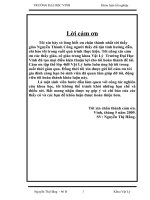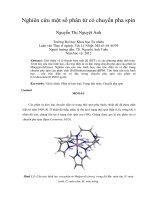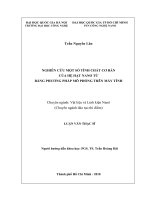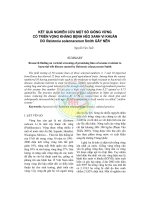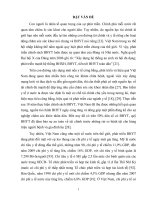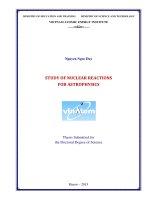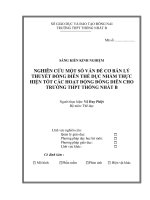Nghiên cứu một số phân tử có chuyển pha spin
Bạn đang xem bản rút gọn của tài liệu. Xem và tải ngay bản đầy đủ của tài liệu tại đây (1.08 MB, 23 trang )
i hc Khoa hc T nhiên
ngành: ý ; 64 44 09
2012
Abstract:
[Co(dioxolene)2(4NO2-py)2].
Keywords: ; ; ;
Content
MỞ ĐẦU
[4]
Hình 1.1: pyrol)
3
(tren), Mn: màu tím, N: màu
2
d
4
d
7
.
[3,24]
[15].
Trong
Mn(pyrol)
3
(tren)]
3d
4
, [Co(dioxolene)
2
(4-NO
2
-py)
2
] d
7
, và
[Fe
III
(salten)(mepepy)]BPh
4
d
5
.
, Mn và Fe nói chung
i.
C 2
PHƢƠNG PHÁP NGHIÊN CỨU
Giới thiệu về lý thuyết phiếm hàm mật độ (DFT)
-
3
Bi ton ca h nhiu ht
:
)1.1.2(), ,(), ,(
2
1
)(
2
11
1
2
1
2
2
NN
N
ji
ji
N
i
iexti
rrErr
rr
e
rV
m
-Openheimer [1]. , V
ext
, E . Thông
, V
ext
, tuy nhiên, V
ext
.
(2.1.1)
:
)2.1.2(), ,(
1 M
RREE
-(E
nn
E
tot
= E + E
nn
(2.1.3)
, (2.1.1)
riêng
[12,17]
[32,35].
. Ví
[35], (CC) [35], và
[31].
4
,
.
DFT,
(E[(r)])
.
cao. ,
[11,23,28].
.
,
E[(r)].
E[(r)].
Phƣơng pháp tính toán
3
[5].
3
. Các tính toán t
này
3
-
c s d m b chính xác cao. Ph
c tính da trên phim hàm PBE [29]. -
Wedig-Stoll-
[7]
[26]. Bán kính các Å,
6
a.u. Khi tin hành tu kin hi t i vng, mc chênh
l dch chuyn ca các nguyên t lt là 1 × 10
5
, 1 × 10
4
và 1 × 10
3
a.u.
5
C 3
Cấu trúc hình học, cấu trúc điện tử và đặc trƣng chuyển pha spin của phân tử
Mn(pyrol)
3
(tren)
3.1. Trạng thái spin thấp
3.1.1. Cấu trúc hình học
Hình 3.1:
3
N7. Mn: màu tím, N: màu xanh, C: màu
Cu trúc hình hc ca phân t Mn(pyrol)
3
Hình 3.1. Trong
N4, N5 và N6 t ng phi t kiu bát din MnN
6
c ch ra trên Hình
3.1(a).
Hình 3.1(b).
- N1,
MnN3 và MnN2, MnN4 và Mn
Hình 3.2
.
6
Hình 3.2N
6
3
Bảng 3.1
3
[12]
[33]
MnN2
1,992
1,986
1,975
MnN4
1,982
1,976
MnN6
2,002
1,996
MnN1
2,051
2,027
MnN3
2,042
2,046
MnN5
2,054
2,057
3
3
(tre-N2/N4/N6.
3.1.2. Cấu trúc đin tử
7
Hình 3.3:
Mn(pyrol)
3
(tren)
3
(tren)
có 2,562
P d
Mn
III
t
2g
Hình 3.3i nhau.
d .
Hình 3.4
3
3
.
Hình 3.5:
3
thái spin up
3
.
PS = 1 và mô
B
chúng tôi
B
spin phân
III
.
3.2. Trng thi spin cao
3.2.1. Cấu trúc hình học
8
Hình 3.6:
N
6
3
3
(tren) không có gì
N
6
. -
N1MnN2 Hình 3.6.
.
Bảng 3.2-
3
tôi
[13]
[34]
MnN2
2,226
2,207
2,054
MnN4
2,006
1,996
MnN6
2,008
2,001
MnN1
2,348
2,328
2,125
MnN3
2,063
2,001
MnN5
2,094
2,057
3.2N2/N4/N6
các
.
3.2.2. Cấu trúc điện tử
-
1MnN2 ()
d
z
2 d
x
2
-y
2
JT
= 1,097
trên Hình 3.7d
z
2 d
x
2
-y
2. ính toán
9
t
2g
và d
z
2
1
= 1,240 eV,
d trong
P 1,7 eV. thái HS t
2g
3
d
z
2
1
d
x
2
-
y
2
0
, 3
3 t
2g
d
z
2.
d
3
(tren)
Và Hình 3.8(a), Hình 3.8(b).
Hình 3.7:
Mn(pyrol)
3
(tren)
HS.
Hình 3.8
3
3
.
P
3
(tren) có spin S = ô
B
ion Mn
III
3,857
B
,
Hình 3.9.
10
Hình 3.9:
3
HS
3
.
3.2.3. Sự chuyển đin tích
Hình 3.10:
Mn(pyrol)
3
(tren) khi
M
3
.
=
MO
AO
MO
và
AO
Bảng 3.4:
LS
HS (n
HS
Mn(pyrol)
3
(tren).
n
LS
(e)
n
HS
(e)
n
HS
/n
LS
Mn
0,177
0,452
2,554
N1
-0,316
-0,359
1,136
N2
-0,328
-0,411
1,253
N3
-0,327
-0,363
1,110
11
N4
-0,323
-0,349
1,080
N5
-0,325
-0,347
1,068
N6
-0,331
-0,376
1,136
Cấu trúc hình học, cấu trúc điện tử và đặc trƣng chuyển pha spin của phức chất
[Fe
III
(salten)(mepepy)]BPh
4
4.1. Cấu trúc hình học
12
Hình 4.1
III
và HS. (Fe: màu tím, N: màu xanh, O:
c t [Fe
III
(salten)(mepepy)]BPh
4
[Fe
III
4
4
III
III
n trên các
Hình 4.1(a) và 4.1(b).
5
N và C
4
5
N và C
4
C=C.
Bảng 4.1. . -
III
(salten)(Mepepy)] trong các
[25]
.
Fe-N1
Fe-N2
Fe-N3
Fe-N4
Fe-O1
Fe-O2
HS
2,175
2,187
2,209
2,252
1,968
1,958
LS
1,995
1,992
2,002
2,045
1,917
1,912
2,022
1,977
1,965
2,035
1,888
1,892
–1,34
0,76
1,88
0,49
1,54
1,06
-N
4
O
2
-
III
4.1-
O 1,9 Å và Fe-N
kê trong 4.1.C-
Fe-
[Fe
III
4.2. Cấu trúc điện tử
d
t
2g
và e
g
Hình 4.2(a)
e
g
13
d
III
ghép
t
2g
Hình 4.2(b) S = 1/2. Trong
-d
P
e
g
S = 5/2, 3
3 t
2g
hai
e
g
Hình 4.2(c). Hình 4.2(b*) và 4.2(c*)
III
(salten)(mepepy)].
Hình 4.2(b*) và 4.2(c*)
-
d LS
4.2
Hình 4.2. (a)
3d
III
3
.
Bảng 4.2.
Fe
O1
O2
N1
N2
N3
N4
m
LS
(
B
)
0,943
0,034
0,041
0,016
0,004
0,002
0,021
m
HS
(
B
)
3,995
0,200
0,197
0,084
0,083
0,080
0,081
n
LS
(e)
0,639
0.515
0,520
0,427
0.412
0,410
0.457
n
HS
(e)
1,075
0,570
0,578
0,499
0,454
0,448
0,525
4.3. Sự tái phân bố điện tích và thay đổi năng lƣợng phân tử
4.3.1. Sự chuyển điện tích
14
=
MO
AO
,
MO
và
AO
III
Hình 4.3
>
< 0).
Hình 4.3
III
3
t
2g
lên e
g
ây màu vàng
xung quanh ion Fe
III
t
2g
lên e
g
4.2. Nhìn vào 4.2 ta
III
4.3.2. Sự thay đổi năng lƣợng và vai trò của sự chuyển đồng phân
III
E
HS
trans
và LS
cis
III
nh toán mà chúng tôi thu
cis
và LS
cis
là 0,222 eV, trong khi
15
trans
và LS
cis
trans
cis
là 5,92 Å
3
cis
cis
là 6,51 Å
3
III
(
Cấu trúc hình học, cấu trúc điện tử, và đặc trƣng chuyển pha spin của phân tử
[Co(dioxolene)
2
(4-NO
2
-py)
2
]
5.1. Cấu trúc hình học
Hình 5.1. (a)
[Co(dioxolene)
2
(4-NO
2
-py)
2
]
(Co: màu xanh , N: màu xanh
dioxolene, -NO
2
-py.
Co(dioxolene)
2
(4-NO
2
-py)
2
]
Hình 5.1(a)
dioxolene 4-NO
2
-py
dioxolene và 4-NO
2
-py Hình 5.1(b) và 5.1(c).
16
[Co(dioxolene)
2
(4-NO
2
-py)
2
] các
Hình 5.2.
Hình 5.2-N
2
O
4
[Co(dioxolene)
2
(4-NO
2
-py)
2
]
thái LS.
Bảng 5.1
o
)
N
2
O
4
[33].
HS
LS
HS
LS
O1-Co-O2
98,712
92,869
92,584
O3-Co-O2
80,981
87,131
87,416
O3-Co-O4
100,318
92,869
92,584
O2-Co-N1
88,951
89,714
89,637
O2-Co-N2
91,703
90,345
90,363
N1-Co-O1
87,380
90,326
89,698
N2-Co-O1
91,951
89,601
90,302
O1-Co-O4
80,135
87,131
87,416
N1-Co-N2
179,128
179,908
180,000
O4-Co-N2
89,315
89,674
89,637
N2-Co-O3
89,302
90,387
89,698
N1-Co-O3
91,370
89,686
90,302
-O 1.90 Å còn Co-N
-O1 = 1,891 Å; Co-O2 = 1,903 Å; Co-O3 = 1,891 Å;
Co-O4 = 1,903 Å; Co-N1 = 1,953 Å; Co-N2 = 1,954 Å [33]-O và Co-
O
4
N
2
Co(dioxolene)
2
(4-NO
2
-py)
2
d
6
d
7
O
4
N
2
-Teller. Và
ng thái LS, ra trên Hình 5.3.
17
Hình 5.3-N
2
O
4
[Co(dioxolene)
2
(4-NO
2
-py)
2
]
thái HS.
-O và Co-
O
4
N
2
trong 5.1dioxolene.
5.2. Cấu trúc điện tử
= 2.142 eV
P e
g
t
2g
e
g
e
g
d
z
2 và d
x
2
-y
2
CoO
4
N
2
Hình 5.5(a) và 5.5(b)
III
t
2g
6
e
g
0
.
Hình 5.4. (a)
Co(dioxolene)
2
(4-NO
2
-py)
2
],
.
18
Hình 5.5. Co(dioxolene)
2
(4-NO
2
-py)
2
LS
Co(dioxolene)
2
(4-NO
2
-py)
2
III
t
2g
6
e
g
0
Hình 5.6(a)
[Co(dioxolene)
2
(4-NO
2
-py)
2
. Hình 5.6(a)
dioxolene
Hình 5.6(a).
Hình 5.6. Co(dioxolene)
2
(4-NO
2
-py)
2
-
d = 1,079 eV, d trong
P
e
g
d
Co(dioxolene)
2
(4-NO
2
-py)
2
II
t
2g
5
e
g
2
Hình 5.4(c)
dioxoleneHình 5.6(b).
dioxolene
B
Co(dioxolene)
2
(4-NO
2
-py)
2
], ngoài ba
d
II
dioxoleneCo(dioxolene)
2
(4-NO
2
-py)
2
19
B
d mà
20
KẾT LUẬN
,
[Mn(pyrol)
3
(tren)
III
(3d
4
), [Fe
III
(salten)(mepepy)]BPh
4
III
(3d
5
), và [Co(dioxolene)
2
(4-NO
2
-py)
2
]
III
-LS (3d
6
) và Co
II
-HS (3d
7
-
g
[Fe
III
(salten)(mepepy)]BPh
4
smepepy.
-
[Co(dioxolene)
2
(4-NO
2
-py)
2
] còn có
dioxolene
III
LS thành Co
II
.
-
[Fe
III
(salten)(mepepy)]BPh
4
B
References
Tiếng anh
1. Born M., Blinder S. M. (1927), Physik, 84, pp. 457-484.
2. Brack M. (1985), Semiclassical description of nuclear bulk properties. In Density-
Functional Methods in Physics, New York: Plenum, pp. 331-379.
3. Decurtins S., Gütlich P., Köhler C. P., Spiering H., Hauser A. (1984), Light-induced
excited spin state trapping in a transition-metal complex: The hexa-1-
21
propyltetrazole-iron (II) tetrafluoroborate spin-crossover systemChem. Phys. Lett,
105(1), pp. 1-4.
4. Delépine M. (1908), Bull. Soc. Chim. Fr, 3, pp. 643.
5. -electron numerical method for solving the local density functional
p. 508-518.
6. Dirac P. A. M. (1930), Note on exchange phenomena in the Thomas-Fermi atomProc.
Cambridge Phil. Soc, 26, pp. 376-385.
7. Dolg M., Wedig U., Stoll H., Preuss H. (1987), Energy-adjusted ab initio
pseudopotentials for the first row transition elements J. Chem. Phys., 86, pp. 866-
872; Bergner A., Dolg M., Kuechle W., Stoll H., Preuss H. (1993), Ab initio
energy-adjusted pseudopotentials for elements of groups 13-17 Mol. Phys., 80, pp.
1431-1441.
8. eterminazione di alcune proprieta
Rend. Accad. Lincei, 6, pp. 602-607.
9.
Rend. Accad.
Lincei, 7, pp. 342-346.
10.
Rend. Z. Phys, 48, pp. 73-79.
11. Fiolhais C., Nogueira F., Marques M. (2003), A Primer in Density Functional Theory,
Springer-Verlag Berlin Heidelberg.
12. Fock V. A. (1930), Z. Phys, 61, pp. 126.
13. Garcia Y., Paulsen H., Schünemann V., Trautweinb A. X. and Wolny J. A. (2007),
Estimate of the vibrational contribution to the entropy change associated with the
spin transition in the d4 systems [MnIII(pyrol)3tren] and [CrII(depe)2I2] Phys.
Chem. Chem. Phys., 9, pp. 11941201.
14. Gombas P. (1949), Die statistischen Theorie des Atomes und Ihre Anwendungen. Wein,
Springer-Verlag.
15. Goodwin H. A., Gütlich P. (2004), Spin crossoverAn overall perspective Top. Curr.
Chem, 233, pp. 1-47.
16. Gross E. K. U., and Dreizler R. M. (1979), Thomas-Fermi approach to diatomic systems.
I. Solution of the Thomas-Fermi and Thomas-Fermi-Dirac-Weizsäcker equations
Phys. Rev. A, 20, pp. 1798-1807.
22
17. Hartree D. R. (1928), Proc. Camb. Phil. Soc, 24, pp. 328.
18. Hohenberg P., Kohn W. (1964), Inhomogeneous Electron Gas 136, pp.
B864-B871.
19. Kohn W., Sham L. J. (1965), Phys. RevSelf-Consistent Equations Including Exchange
and Correlation Effects 140, pp. A1133-1138.
20. Konigsbruggen P. J. van, Maeda Y., Oshio H. (2004), Top. Curr. Chem Spin Crossover
in Transition Metal Compounds I 233, pp. 259.
21. Levy M., Perdew J. P., and Sahni V. (1984), Phys. Rev. A, Exact differential equation for
the density and ionization energy of a many-particle system 30, pp. 2745-2748.
22. Lieb E. H. (1981), Rev. Mod. Phys, Thomas-fermi and related theories of atoms and
molecules 53, pp. 603-641.
23. M. Springborg (1997), Density-Functional Methods in Chemistry and Materials Science,
JOHN WILEY & SONS.
24. McGarvey J. J., Lawthers I. (1982), J. Chem. Soc., Chem. Commun, 16,
Photochemically- 5T equilibrium in Fe11
complexes by pulsed laser irradiation in the metal-to-ligand charge-transfer
absorption band 906-907.
25. Mokdad A., Larsen R.W. (2010)Photothermal studies of the room temperature photo-
induced spin state change in the Fe(III)(salten)(mepepy) complex, Inorganica
Chimica Acta, 363, pp. 33383344.
26. Mulliken R. S. (1955), J. Chem. Phys., Electronic Population Analysis on LCAO-MO
Molecular Wave Functions. I 23, pp. 1833-1840; Mulliken R. S. (1955),
Electronic Population Analysis on LCAO-MO Molecular Wave Functions. II J.
Chem. Phys., 23, pp. 1841-1846.
27. Nguyen A. T. (2012)
Several Fe
II
Spin- Journal of Applied Physics, 111, pp.
07D101-07D103.
28. Parr R. G., Yang W. (1989), Density-Functional Theory of Atoms and Molecules, Oxford
University Press, Oxford.
29. Perdew J. P., Burke K., Ernzerhof M. (1996), Phys. Rev. Lett., Generalized Gradient
Approximation Made Simple 77, pp. 3865-3868.
30. Pople J. A. (1999), Rev. Mod. PhysNobel Lecture: Quantum chemical models, 71, pp.
1267-1274.
23
31. Roos B. O., and Taylor P. R. (1980), Chem. Phys A complete active space SCF method
(CASSCF) using a density matrix formulated super-CI approach 48(2), pp. 157-
173.
32. Roothaan C. C. J. (1951), Rev. Mod. Phys New Developments in Molecular Orbital
Theory 23(2), pp. 69-89.
33. Schmidt R. D., Shultz D. A., Martin J. D., and Boyle P. D. (2010)Goldilocks Effect in
Magnetic Bistability: Remote Substituent Modulation and Lattice Control of
Photoinduced Valence Tautomerism and Light-Induced Thermal Hysteresis, J. Am.
Chem. Soc, 132, pp. 62616273.
34. Sim P. G. and Sinn E. (1981), J. Am. Chem. Soc., First manganese(III) spin crossover,
first d4 crossover. Comment on cytochrome oxidase 103(1), pp. 241-243.
35. Szabo A., and Ostlund N. S. (1996), Modern Quantum Chemistry, Dover.
36. Thomas L. H. (1975), The calculation of atomic fieldsProc. Camb. Phil. Soc, 23, pp.
542-548.
37. Weber B. (2009), Coordination Chemistry Reviews Spin crossover complexes with
N4O2 coordination sphereThe influence of covalent linkers on cooperative
interactions 253, pp. 2432-2449.
38. Z. Phys, 96, pp. 431-458.
39. Yang W., Parr R. G., Lee C. (1986), Phys. Rev. AVarious functionals for the kinetic
energy density of an atom or molecule 34(6), pp. 4586-4590.
40. Yonei K. (1971), An extended Thosmas-Fermi-Dirac theory for
diatomic molecule 31, pp. 882-894.


